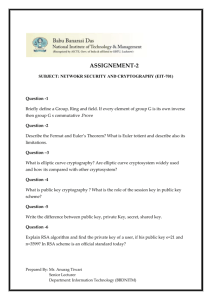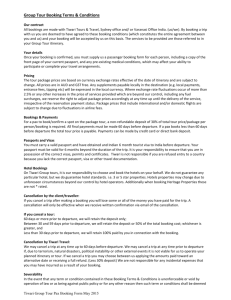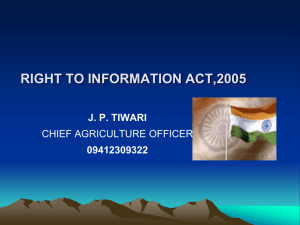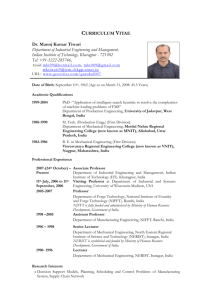Lecture 2
advertisement
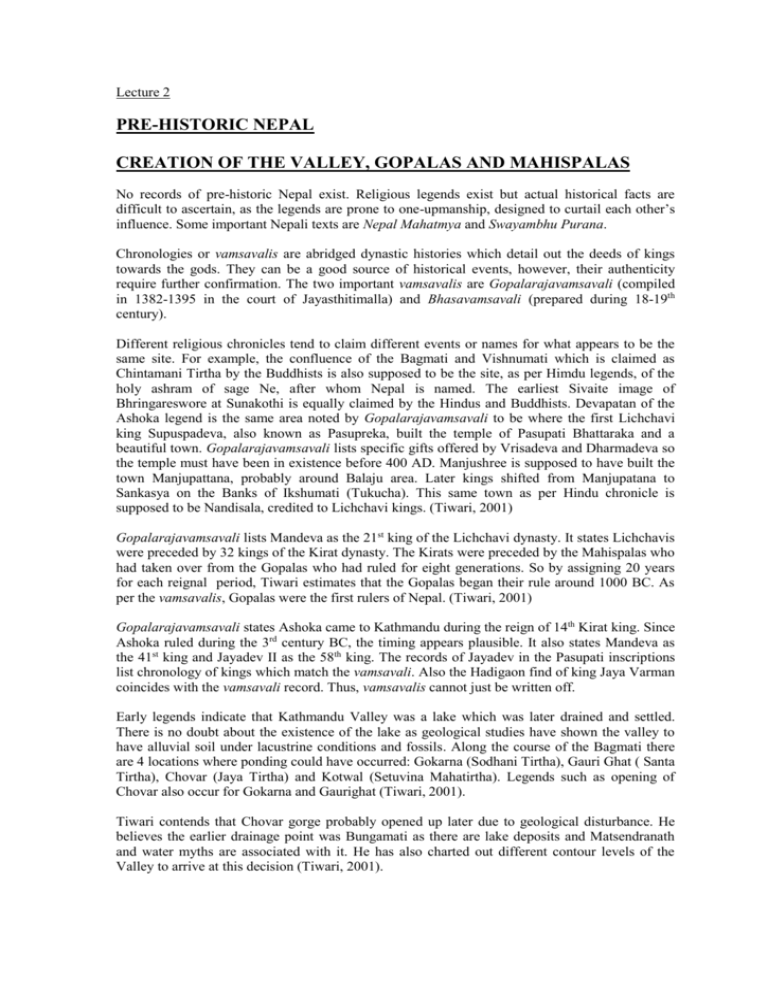
Lecture 2 PRE-HISTORIC NEPAL CREATION OF THE VALLEY, GOPALAS AND MAHISPALAS No records of pre-historic Nepal exist. Religious legends exist but actual historical facts are difficult to ascertain, as the legends are prone to one-upmanship, designed to curtail each other’s influence. Some important Nepali texts are Nepal Mahatmya and Swayambhu Purana. Chronologies or vamsavalis are abridged dynastic histories which detail out the deeds of kings towards the gods. They can be a good source of historical events, however, their authenticity require further confirmation. The two important vamsavalis are Gopalarajavamsavali (compiled in 1382-1395 in the court of Jayasthitimalla) and Bhasavamsavali (prepared during 18-19th century). Different religious chronicles tend to claim different events or names for what appears to be the same site. For example, the confluence of the Bagmati and Vishnumati which is claimed as Chintamani Tirtha by the Buddhists is also supposed to be the site, as per Himdu legends, of the holy ashram of sage Ne, after whom Nepal is named. The earliest Sivaite image of Bhringareswore at Sunakothi is equally claimed by the Hindus and Buddhists. Devapatan of the Ashoka legend is the same area noted by Gopalarajavamsavali to be where the first Lichchavi king Supuspadeva, also known as Pasupreka, built the temple of Pasupati Bhattaraka and a beautiful town. Gopalarajavamsavali lists specific gifts offered by Vrisadeva and Dharmadeva so the temple must have been in existence before 400 AD. Manjushree is supposed to have built the town Manjupattana, probably around Balaju area. Later kings shifted from Manjupatana to Sankasya on the Banks of Ikshumati (Tukucha). This same town as per Hindu chronicle is supposed to be Nandisala, credited to Lichchavi kings. (Tiwari, 2001) Gopalarajavamsavali lists Mandeva as the 21st king of the Lichchavi dynasty. It states Lichchavis were preceded by 32 kings of the Kirat dynasty. The Kirats were preceded by the Mahispalas who had taken over from the Gopalas who had ruled for eight generations. So by assigning 20 years for each reignal period, Tiwari estimates that the Gopalas began their rule around 1000 BC. As per the vamsavalis, Gopalas were the first rulers of Nepal. (Tiwari, 2001) Gopalarajavamsavali states Ashoka came to Kathmandu during the reign of 14th Kirat king. Since Ashoka ruled during the 3rd century BC, the timing appears plausible. It also states Mandeva as the 41st king and Jayadev II as the 58th king. The records of Jayadev in the Pasupati inscriptions list chronology of kings which match the vamsavali. Also the Hadigaon find of king Jaya Varman coincides with the vamsavali record. Thus, vamsavalis cannot just be written off. Early legends indicate that Kathmandu Valley was a lake which was later drained and settled. There is no doubt about the existence of the lake as geological studies have shown the valley to have alluvial soil under lacustrine conditions and fossils. Along the course of the Bagmati there are 4 locations where ponding could have occurred: Gokarna (Sodhani Tirtha), Gauri Ghat ( Santa Tirtha), Chovar (Jaya Tirtha) and Kotwal (Setuvina Mahatirtha). Legends such as opening of Chovar also occur for Gokarna and Gaurighat (Tiwari, 2001). Tiwari contends that Chovar gorge probably opened up later due to geological disturbance. He believes the earlier drainage point was Bungamati as there are lake deposits and Matsendranath and water myths are associated with it. He has also charted out different contour levels of the Valley to arrive at this decision (Tiwari, 2001). Nepalmahatmya tells of Krishna draining the lake but the Swayambhu Purana tells of an earlier period when the lake Kalihrada or Naghrada was full of snakes. On Kartik Purnima a lotus sown by Vipasubuddha appeared, which emanated a self-existing flame, Swayambhu. Later after Manjushree drained the lake a sage took to protect the pure light from evil forces and built Swayambhu Mahachaitya. (Tiwari, 2005). After the drying of the lake the hillocks remaining out of the water were probably the early habitat of the aboriginal settlers. Tiwari hypothesizes that the earliest settlements were on the higher reaches of the surrounding hills. Settlements moved down along hill spurs jutting into valley along Changunarayan, Jagdol, Kapan, Tokha, Mahankal, Balaju, Swayambhu, Naikap, Bungamati, Sunakothi, Katunje, Sanga-Tathali. Later settlements extended to Bhaktapur, Thimi, Gothatar, Devpatan, Baluwatar, Manamaiju, Kirtipur, Chovar, Okhthali, Lagan and Matitar. By early Lichchavi period movement had occurred to occupy Patan, Hadigaon and Kathmandu (Tiwari, 2001). Slusser contends that people of Tibeto-Burman origin probably drifted down from the harsh Tibetan plateau and were ancestors of the current hill tribes and Newars. (Slusser, 1982). As per the legends, the aboriginal people were serpent worshippers and were called Nagas. The legends portray the Nagas as a matriarchal society who worshipped simple unhewn stones as tribal female deities dedicated to Kali, Kumari, Devi, Malika, Maiju and Ajima. Traces of such customs still remain with the Newars, the Kiratas and Rajbanshis (Tiwari, 2001). The similarity in place names of Tistung-Palung-Chitlang to the south of Chandragiri hills, now inhabited by the Hale and Gwa caste groups of Newars, and Chepang area, as well as the linguistic relations between the Chepangs, Newars and Kirats indicate they could have common ancestry and could be descendents of the Nagas. The Newar name for Patan, Yala, is believed to originate from the Kirat king Yellung or Yalambara, the alleged founder of the dynasty and the city. Chyasal-tol is believed to commemorate the 800 Kiratas slain in battle with the Lichchavis (Tiwari, 2001). Although the chronicles seem to suggest the Gopalas and Mahispalas came from India, Nirish Nepal believes their origins to be derived from the pastoral community of Nagas who broke up into two groups: Gopalas (cow herders) and Mahispalas (buffalo herders). They appear to be aboriginal herdsmen of the Bagmati region and the primogenitors of the Newars. The Newar caste hierarchy has the Hale or Gwa caste divided into two sub-sections: Sapu (cow milker) and Me-pu (buffalo milker). The predominance of Hale and Gwa castes among the Newars in Taukhel, Nhulu, Kunchha, Papung, Pulagaun and Shikarkot villages of Tistung-Taukhel-Chitlang regions indicate they are not mythical but real historical people (Tiwari, 2001). According to the vamsavalis the seven daughter groups of Gopalas and Mahispalas occupied seven villages of Kathmandu: Satungal, Boshigaun, Machchegaun, Taukhel (Tahakhel?), Kirtipur, Lohankot and Nagam (Panga). These villages have concentrations of Gwas and Hales. During the Jatra of Satgaons, all the seven guardian goddesses of the villages come together at the site of the mother goddess of Vishandevi temple on the banks of the river Balkhu (Indramati Ganga). Podes are the group leaders of the festivities. Podes are also guardians of the matrika temples eg. Tunaldevi Ajima of Chandol datable to the 5th century. Podes also do not practice Yihi of the Newars . Could they be older than the Gopalas? Just as indicated by the legends, it is possible the Gopalas and Mahispalas occupied the higher lands around Palung, Tistung, Satgaon etc. with their capital at Matatirtha (Tiwari, 2001). Although the Gopalas and Mahispalas were believed to follow Vaishnavite Hinduism and the Kiratas followed Saivite Hinduism, Buddhism probably arrived earlier. Buddhist and Hindu legends seem to refer to the same early sites of religious or secular importance to pre-Lichchavi settlers. If the logic of movement of settlements from the higher to the lower level over time is to be accepted, then the Buddhist sites were probably older as they were located on the higher level of the same mountain spurs. Ichangu Narayan – Ichangu Vipaswibuddha – Jamacho Sikha Narayan – Pharping Sikhitathagata – Champadevi Bishankhu Narayan – Bishankhu Viswobhubuddha – Phulchoki Changu Narayan – Changu Manjushri – Manichurthan Location of Mahadev Pokhari, Pokhari Thumko, Pokhari Bhanjhyang and Dahachowk in the general areas of the Buddhist legends tends to suggest these hill ponds served as water supply reservoirs for large settlements nearby. The profusion of many non-Sanskrit names around these regions further reinforces the theory that Kirata or pre-Lichchavi settlements existed there. Their location seems to suggest their strategic importance in regard to control of the passes to the valley for military as well as trade purposes. The settlements probably doubled as military garrisons and trading posts at the time of the Sravasti monks. Highways criss-crossed the valley linking the settlements. KIRATAS Mahabharat mentions Kiratas as aligned to Kauravas. Shiva also appears as a Kirata to give Arjuna the weapon of Pashupat. The Puranas ( edited in 400 AD?) mention Kiratas as people of the Madhyadesh, located in the Himalayas next to Kamrupa ( Slusser, 1982). Kira (edge) ta (roam)- so Kiratas thought to refer to aboriginal people roaming at the edge of Aryan settlements. Vamsavalis indicate Kiratas as the successors of the Gopalas and the Mahispalas. Some vamsavalis mention the Kiratas took the Bagmati route from the south to enter the valley (Tiwari, 2001). Slusser suggests earlier drifters from the Tibetan plateau to be the ancestors of Kiratas who in turn were the ancestors of the Newars (Slusser, 1982). Whereas the Gopalas and Mahispalas were thought to have come from India and followed Vedic Hinduism with Vaisnavite inclination, the Kiratas were thought to be the followers of Shiva. Kirateswore Sivalinga and proto-Lichchvi Kali of Aryaghat are indicative of Sivaite following among Kiratas. According to N. M. Thulung, Kirata folklore suggests the Kiratas originated from “Mong” in China. They split into the Chyan, Tyan and Hyan genets. The Chyan moved south to the Indus Valley and from there into Nepal after the Aryan invasion. The Aryans entered the Indus Valley in waves between 2000-1200 BC and expanded into the Gangetic plains. The Aryans referred to the original inhabitants as “Dasa”, “Dasyu” and later “Saka” and they were excluded from the Aryan society because they had different religious beliefs. The Manusmriti identifies the Kiratas as one of the eleven tribes who inhabited the Indus-Saraswoti region. Tiwari believes some of these tribes were forced to move away from their homeland and into the Kumaon region. While the Khas set up their kingdom in the Kumaon hills, the Kiratas moved on to settle in the Kathmandu Valley (Tiwari, 2002). While no remains of temples were found in the Indus Valley, archaeologists have concluded that worship of the primal form of Siva, Rudra, was popular. The easternmost town of the Sakas dug up by archaeologists so far is Alamgirpur which lies a little to the north of Delhi. Thus, the physical distance as well as the time gap between the Indus civilization and the Kathmandu Valley is not as great as it seems. Further east and closer to Nepal lay the Sakya kingdom of Kapilavastu. They are believed to belong to the Khas clan of the Sakas and they also extensively used brick construction. Considering the fact that the Sakyas and the Kirats were contemporaneous, it is not difficult to conceive that the Kirats may have traveled to Kathmandu Valley after being displaced from their ancestral homeland by the Aryans. In his book “The Brick and the Bull” Tiwari hypothesizes that when the “Sakas” moved away from their homeland and into the Kathmandu Valley, they brought along with them the knowledge of the 18 building trade groups, among these the art of brick building, water tanks, drainage system etc. They also brought their religion (Tiwari, 2002). The discovery of 2 nd century BC brick construction by the Italian excavation team near the Satyanarayan temple gives conclusive proof that the Kiratas had advanced knowledge of brick construction. Terracota figurines of humped bulls and matrika sculptures suggest Saiva and mother goddess worship was prevalent among the local population. That other dynasties preceded Lichchavis is proven by the fact that Sanskrit inscriptions of Lichchavi period used mostly non-Sanskrit terms for administrative and personal names (Rogamacau, Sindrira, Kedumbata) and more than 80% place names including that of hamlets, towns, rivers etc which have survived till today, eg. Pharping, Balkhu, Balambu, Mhepi, Khopring, Tukucha etc. If Lichchavi rule began from the 1st century and older names survived for more than 500 years when the Lichchavi inscriptions were made, it indicates that there were well established towns and villages during the Kirata period and there was continued influence of the Kirata language on non-Sanskrit language (Tiwari, 2001). The Kiratas worshipped Ajima (Yumi) or grandmother and Ajju or Bhairav or Hathvan (Theba) or grandfather and these traditions are existent in eastern Nepal. Some writers consider the imageless piths of Kanga Ajima, Luti Ajima and Maiti Ajima as remains of Kirata goddesses. Yumi was worshipped as mother goddess; Rais and Limbus also worship Yumis. Popular Newari belief links Indrachowk Akash Bhairav and Pachali Bhairav to Kirata king Yalambar Hang and his son Pabbi respectively. Places worshipped as Bhairav were memorials of kings: Akash Bhairav of Indrachowk commemorates King Yalambar while Pachali Bhairav is for the Kirata king of Pharping. One interesting point is the Hadigaon inscription of Amshuvarman listing state recognized religious sites. None of the above sites were cited or were lumped under “tadnyadevakulam” indicating they did not find favor with the then rulers (Tiwari, 2001). Many early Kirata settlements probably emerged around mother goddesses and Bhairav temples. There probably were also Kirat defenses on hilltops such as Phulchoki, Nagarjun, Champa Devi, Nagarkot gap, Nuwakot etc. The vamsavalis tell of Kirata palaces at Phulchoki, Godavari, Gokarna and later Pulchowk but there are no remains to corroborate the statements. The Mandeva palace at Gokarna is thought to be the Kirata palace but since it is a cave, its likelihood being the remains of a Kirata palace is remote. The Kirata towns on hilltops were referred to as pringgas eg. Pharping, Khopring (Bhaktapur) and dula suffix meant settlements on slopes: Kupondol (Newari term dol for dula). The Kirata capital appears to have shifted frequently. Chronicles mention the capital shifted from Kiratsur at Thankot to Andipringga (Hadigaon) and to Patan. According to Tiwari, earlier, Bishandevi of Balkhu near Naikap seems to have represented the power of the state so when the Kiratas set up their capital at Andipringga, they brought her and set her up in their capital somewhere near the current location of Satyanarayan temple. This act invested the Kiratas with the power to rule. Later, during Lichchavi rule, Narayan became the god which invested the power to rule, so the Lichchavis erected the Narayan temple at the site of the goddess of Andipringga and relocated the temple of the goddess to Tunaldevi at Chandol (Tiwari, 2002). Popular belief is that Patuko mound in central Patan is of Kirata origin. Some historians have concluded that Kirata king Patuko shifted his palace from Gokarna to Sankhamul. Patuko is thought to have been the second last Kirat king so Patuko is probably a historical figure of Kiratas. Kirata culture used bricks for built structures since early times. Tiwari believes Kiratas used bricks and timber to build palaces and transient buildings for commoners and contends Sankhamul as the palace site, probably where the Patuko mound stands (Tiwari, 2001). Chyasal tol is one of the oldest quarters. Chyasal and Guita are exclusively inhabited by Jyapus, suggesting their lineage closest to ancient Nepal. The Kiratas early relations with Patan is reinforced by the fact that two sites are considered venerable by the present day Kiratas: Siddhilaxmi temple near Tyagal tol and Tikhel at the southwest corner of Patan (Slusser, 1982). Although legend has it that the Lichchavis slew 800 Kiratas at Chyasal tol, some believe Lichchavi takeover of Kiratas was not violent as the Lichchavis make no mention of diaspora, fire or sword or boasts of victory (Slusser, 1982). Lichchavi inscriptions suggest Kirata settlements in the form of small towns were situated on the upper reaches of the hill slopes. They had nonSanskrit names which continued even during Lichchavi periods. Some of these were Ahidumkottagrama (around Gokarna), Lembatidrangga (Lele), Mathanggrama (west of Thamel), Lohpring and Muhpring (east and northeast of Pasupati), Kadunggrama, Ferangkotta, Kichpringgrama, Pasinkhya, Thenchograma and Jolpringgrama (all around Thankot), Konko (south of Bhaktapur), Thanthuridrangga (near Budanilkantha) etc. Excavations in Hadigaon have revealed pre-Lichchavi brick walls (167 BC -–1 AD) and a water tap tray with the name Andigrama suggesting the site belonged to the Kirata settlement of Andipringga. In current Kirata terminology and probably in the ancient times as well, “cho” and “gung” indicate places located on higher grounds. The Lichchavi inscriptions have many such names e.g. Haragung, Dhandangung, Chhogung, Lumbancho, Pahancho, Dhancho, Gungrihara, Gungshikhara etc. Spring fed ponds and hill top ponds, natural or man-made, were important to Kiratas as they were settled on higher grounds. The Lichchavis and later on the Mallas continued to use these as their source of water supply for their towns. The small settlements of Yambi (current Indrachowk), Jama (current Jamal), Lanjagvala (current Lagan) and their capital Andipringga (current Hadigaon) further to the east were aligned along the main trade route from India to Tibet, the Kampo-Yambi Marga (Indrachowk -Ason-Jamal-NaxalHadigaon-Dhumbarahi-across Dhobikhola-Mahankal-Kapan)(Tiwari, 2001). Lichchavis later added the larger town of Daxinakoligram to the south of Yambi.

